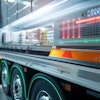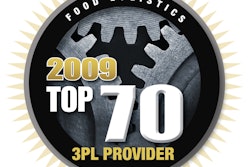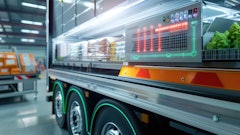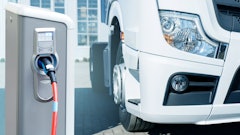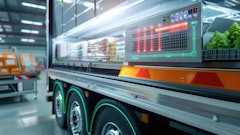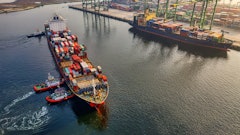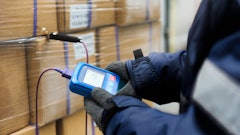
Many automated material handling systems can deliver solid, incremental improvements in warehouse efficiency, accuracy and space utilization.
Then there are the installations that are real game-changers.
This was the case when Alpha Baking Co. partnered with Frozen Assets Cold Storage, a Chicago-based third-party logistics provider (3PL), to develop a dedicated facility for handling distribution of its frozen bakery products. Driven by a need for both speed and storage density, the pair turned to Konstant and their Pallet Runner system to handle put away, storage and retrieval of Alpha’s high volume movers.
Pallet Runner is a highly customized, individually configurable system that combines high-density racking with automated, remote controlled carts to take over most of the work of shuttling pallets in and out of storage. The system was developed and is manufactured by Konstant of Rolling Meadows, IL and Oakville, Ontario.
By incorporating the Pallet Runner system, Frozen Assets and Alpha Baking were able to design a high-rise distribution center that accommodates more than 8,000 pallet positions in just 41,000 square feet of freezer space.
Not only did Pallet Runner provide the storage density required it also yielded dramatic reductions in labor, warehouse equipment and other direct operating costs. It generates significant energy savings as well. Perhaps more importantly, Pallet Runner has facilitated a dramatic acceleration of transport service and turnaround time thereby winning accolades from Alpha’s customers and the contract carriers who service them.
ACCOMMODATING RAPID GROWTH
A privately owned commercial bakery with four production facilities in Chicago, La Porte, IN, and Manitowoc, WI, Alpha Baking began utilizing Frozen Assets for its cold storage and distribution operations a little over a year after the 3PL first opened its doors in 2004.
With sales of frozen product lines expanding rapidly over the last 10 years, and freezer operations consequently becoming more critical, Alpha decided it could no longer rely on public cold storage warehouses, notes Bob McGuire, vice president of logistics.
“Their typical Monday through Friday work week did not line up well with the requirements of our seven-day-a-week operations,” he explains.
Founded on a business model that focuses on providing customers with separate warehouse “condos” and dedicated staff in its Chicago facility, Frozen Assets offered Alpha the control and flexibility it needed, McGuire says, obviating the need to build and operate its own distribution center.
As frozen sales continued to grow by leaps and bounds, however, the number of pallet positions required by Alpha more than doubled in less than two years. As a result, some product began to spill over from its dedicated area at Frozen Assets into the public cold storage side of the 3PL’s facility; particularly during peak sales periods and pre-season builds. The need to pull product from multiple locations inside the warehouse negatively impacted the efficiencies and speed of service the bakery company had originally sought and achieved by outsourcing its frozen distribution with Frozen Assets.
In 2007 the two companies agreed to jointly develop a new, wholly dedicated frozen distribution center for Alpha, adjacent to Frozen Assets’ existing warehouse. Both companies were willing and ready to sign a 10-year commitment to this relationship. The big challenge they faced, however, was an extremely constrained space available for construction next to Frozen Assets’ original, 250,000-square-foot facility; right in the city of Chicago. Somehow, on a lot totaling less than two acres, Frozen Assets needed to find room for a distribution center that would accommodate 8,300 pallet positions, all 96 inches high, as well as a dock with 15 doors, miscellaneous staging, maintenance area and office space.
Mike Meehan, president of Quality Storage Products Inc., Tinley Park, IL, worked closely with Konstant’s president and CEO, Peter McCarthy as well as Alpha and Frozen Assets personnel to design the facility. Meehan notes that the team initially considered both push back and pallet flow rack. Both alternatives, however, would have required too many aisles which could be utilized for storage in the Pallet Runner system.
Given the depth of the system (20-22 pallets), pallet flow rack, was not considered because an entire storage level would have been lost due to the pitch required to make a gravity system work.
“Something like 1,800 pallet positions would have been lost to aisles for forklift access if we’d gone with an exclusively push back rack design. Pallet flow rack would have required only two long aisles, for loading and unloading, but that would still have eliminated 700 spaces, plus the pitch required would have restrained the storage height to just four pallets instead of five high,” Meehan comments.
“Other than a fully automated storage and retrieval system, nothing we found aside from Pallet Runner provided the storage density needed to make the site work. But an AS/RS would have cost a fortune, and also would have locked Frozen Assets into a design that limited flexibility to reconfigure the facility in the future,” he says.
Working closely with Konstant, the team toured several sites to see Pallet Runner at work in various configurations. Once an operational comfort level was achieved, the design was built around Konstant’s nearly 100 foot deep rack system. Construction began at the end of 2007 and the partners moved in and began shipping from the new facility in August 2008.
HOW IT WORKS
The Konstant Pallet Runner GEN3 carts are remote-controlled, powered platforms that run on rails attached to the 24 pallet deep rack structure. The GEN3 cart carries pallets back and forth along the length of a single lane or “tunnel.” The carts are portable, rather than being fixed within each lane. This feature allows users to operate the system with minimal capital investment.
To start, a forklift driver places the cart at the front of a lane at the desired rack level. The driver then keys in a simple command on a preprogrammed, wireless remote control to direct the cart to retrieve or store pallets. Once the instruction is given, the Pallet Runner cart works unattended. The cart delivers the desired number of pallets to the front of the lane for shipping, or in the case of receiving and put away, transporting them deep into the lane for storage.
Only one aisle is required to access pallets within the system. This design resulted in huge space savings over conventional, forklift-serviced, racks. Moreover, the movement of pallets by warehouse personnel is reduced to just ferrying them back and forth between the end of a lane and the warehouse dock for shipping or receiving.
The short distance travelled results in a significant reduction in the man hours and forklift equipment required to move pallets in and out of storage. The short travel distance also improves storage-to-dock turnarounds, lowers energy use, and reduces damage to product, racks and other warehouse equipment.
Tom Wick, Frozen Assets’ operations manager, says put away time is about 40 percent faster with Pallet Runner compared to conventional, forklift serviced racks. “Pallet Runner is actually doing the putaway while the forklift driver can go back to the dock to get the next load.
“We’re getting the same kinds of efficiencies in loading trucks on the outbound side” he adds. Wick notes that the warehouse averages roughly a 45-minute turnaround for transport drivers who arrive on time for appointments.
“We’re talking about a 24 pallet truckload; measured from the time the driver checks in before even backing up to the dock, until the truck is fully loaded, bills are signed, and the driver is ready to get on his way,” Wick points out.
And that level of performance is continuing to improve.
“Recently we hit our best week—logging just a 31-minute turnaround,” he reports. Fritz Bauernschmidt, Alpha’s on-site facilitator at Frozen Assets, estimates that loading time itself, on average, has been cut in half. Moreover, the warehouse manages to operate at such speeds consistently while maintaining an order accuracy rate of 99.95 percent.
The speed at which Pallet Runner allows Frozen Assets to load high volume movers contributes to its ability to thoroughly check every load and assure accuracy in all product shipped, Wick notes.
“It also contributes to less damage, because there’s less handling of product, and you don’t have forktruck operators driving into the racking.” he comments.
Frozen Assets ships an average of 95,000 cases weekly for Alpha Baking with a crew that numbers just 16 men over three shifts.
“All of our receiving is done at night by just four workers and one lead man. We also have a crew of two picking at night. During the day we have five men picking and four loading, plus myself as lead,” Wick explains. “Without Pallet Runner, it’s inconceivable we could come anywhere near matching this level of productivity. We’d have to increase our staff by at least 25 to 30 percent.”
PLANNING THE LAYOUT
To design the facility, the team started by closely analyzing item movement patterns.
“We determined that case pick averages 27 percent of the operation, while 73 percent is full pallet pick,” Wick notes.
Pallet Runner is used only for the fastest of the full pallet movers—SKUs whose velocity averages at least a full truckload daily. The Pallet Runner lanes are 24 pallets deep, i.e. a full truckload’s worth. Each truckload received is put away into a single lane, and during selection, lanes are emptied in FIFO order. No new product is put away in a lane until that lane has been fully emptied, notes Baurenschmidt.
Frozen Assets’ RF-equipped warehouse management system incorporates directed put away and preprinted pallet license plates. The system directs workers where to put each pallet that is unloaded, whether in the Pallet Runner deep rack section or into other Konstant rack sections for slower moving pallet loads and case pick SKUs.
“When planning the system, one concern we had was the amount of honeycombing that could take place,” notes McGuire. “But in fact, it turned out to be less of a challenge than we thought, because all the items that go into the Pallet Runner tunnels are so fast moving that it hasn’t become an issue.”
In all, the Pallet Runner deep rack area holds 4,080 pallets—nearly half the facility’s total pallet positions, in less than 15,000 square feet of space. The remaining 26,000 square feet of frozen storage consists primarily of Konstant push back rack, used for SKUs that move in full pallet quantities of less than a truckload daily, plus case pick items and reserve storage to feed the case pick slots.
In addition, notes Wick, “We have a staging area running the entire length of the facility along the wall that separates the dock from the freezer, with push back rack that provides almost 400 pallet positions used for staged items.”
This allows Frozen Assets to prepick and stage approximately 70 percent of orders at night. The fast moving pallets come directly out of the Pallet Runner tunnels. Those fast moving SKUs travel directly from the 24 pallet deep racking to the loading dock only after trucks have pulled up for loading.
“This enables us to handle product as few times as possible,” Wick points out. “One of the challenges of the site was that to accommodate the pallet positions we needed, the dock could measure only 31 feet, minus the six-foot dock plates. The speed we get from Pallet Runner, and the ability to move pallets so quickly directly from the tunnels to the trucks, allows us to work with a short dock, that is in reality much smaller than would normally be required.”
LOW MAINTENANCE, FAST TURNAROUND
Other advantages of Pallet Runner are simplicity and ease of use.
“The Pallet Runner carts are very simple and easy machines to work with. The training required was minimal, and everyone was comfortable with the system in three weeks,” says Wick.
This included acclimating not just to Pallet Runner, but also to the new high lift fork trucks brought in to feed and retrieve pallets and the Pallet Runner carts to and from the end points of the deep rack tunnels. The facilities five-pallet-high design requires lifts that reach as high as 38 feet, Meehan notes.
High-lift fork trucks are used to move Pallet Runner carts and pallets of product up and down at the front of each tunnel, Wick points out, while warehouse personnel use electric pallet jacks and conventional forklifts to ferry the 96” tall pallets from the floor staging area at the front of the storage tunnels to each outbound semi trailer for loading.
Only four Pallet Runner carts are needed to handle all the movement of pallets in and out of the deep racking.
The Pallet Runner Gen3 Carts themselves require minimal maintenance. Frozen Assets employs eight sets of batteries, two for each cart. The batteries generally require recharging after each shift. Fully charging a low battery takes approximately six hours. Changing the batteries out of a cart takes less than a minute. Carts are programmed to alert users before batteries run out. In fact, when the charge drops below a certain threshold, the cart will automatically come to the front of the tunnel and will not respond to further commands to move pallets until the batteries have been changed.
Managing batteries for the four Pallet Runner carts consumes considerably less time and energy than would be required to power the number of forklifts that would be needed with a conventional racking system handling the same amount of product. This does not include the additional maintenance required by forklifts, greater number of staff that would be necessary to operate, lower incidence of accidental damage, and on and on.
The system even saves on lighting costs, as there is no need to light the deep rack section of the freezer where the Pallet Runner carts operate.
McGuire adds that the productivity gains achieved are not limited to just inside the warehouse. “Our own drivers who deliver product to the distribution center, and the other carriers who bring product in and out also gain due to the warehouse’s quick turnaround time.”
Faster inbound and outbound operations also mean less truck idle time, and less time running trailer refrigeration systems while trucks just stand and wait; another environmental plus.
Another key benefit of faster turnaround times is improved food safety, McGuire points out. “Many of our outbounds are LTLs, and I can’t overstate the importance of one of our goals, which was to limit the amount of time trucks have to wait here with their doors open, while product already on the truck gets exposed. When we put an emphasis on turning trucks quickly, especially LTL outbounds, that’s a contribution to protecting the integrity of the food chain.”
POSITIVE FEEDBACK FROM PARTNERS
Nick Gruibisich, logistics director for Alpha Baking, adds that these benefits have helped him create an effective distribution program.
“Carriers are happy to come in here, knowing they will be in and out so quickly. That’s a big plus in securing carriers and negotiating pricing.”
Wick, who himself previously worked as a truck driver, adds, “Word on the street from truck drivers really travels, and that kind of reputation can make or break a warehouse. Drivers who come here know they’ll get a level of service they haven’t seen anywhere else.”
“The only complaints we get from the carriers who service our customers,” McGuire says, “is that their drivers get out so fast, they don’t have enough time to come in and take a nap.”
More seriously, he says the tremendous positive feedback and high marks on performance benchmarks which the new facility has generated among customers “has absolutely provided opportunities to grow our business and garner new customers.”
SUSTAINABLE ADVANTAGES
In addition to its many other benefits, the Pallet Runner storage system has several “green” advantages that provide ongoing energy savings at Frozen Assets Cold Storage. Some factors are difficult to measure, but all contribute to a more energy-efficient and environmentally responsible warehouse operation:
• Better use of costly refrigerated space (59 percent better space utilization)* means overall improved utility efficiency;
• Shorter fork lift driving distance (estimated at 40-50 percent less)* means less electrical consumption and truck maintenance;
• Faster truck loading and unloading process means reduced energy loss during “open dock/open truck door” time;
• Less idle time for waiting trucks means reduced fuel consumption (refrigerated trucks require more fuel per minute than most vehicles);
• More efficient lighting—no illumination is required in the deep lanes of the Pallet Runner system, reducing required lighted space by nearly 50 percent.*
* Comparisons are with the FACS main building which is adjacent to this Pallet Runner site.


